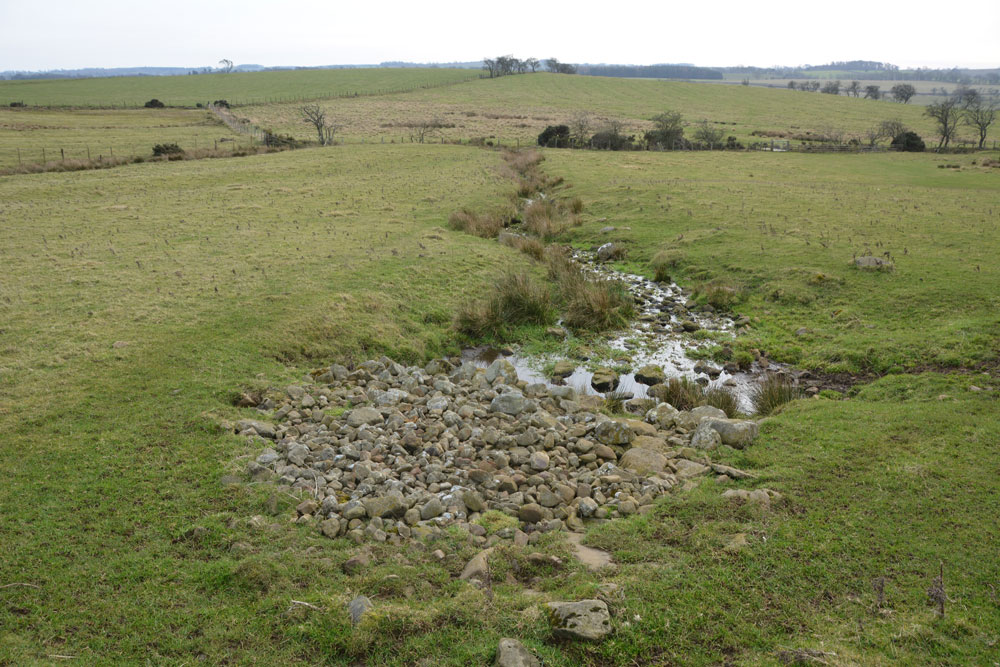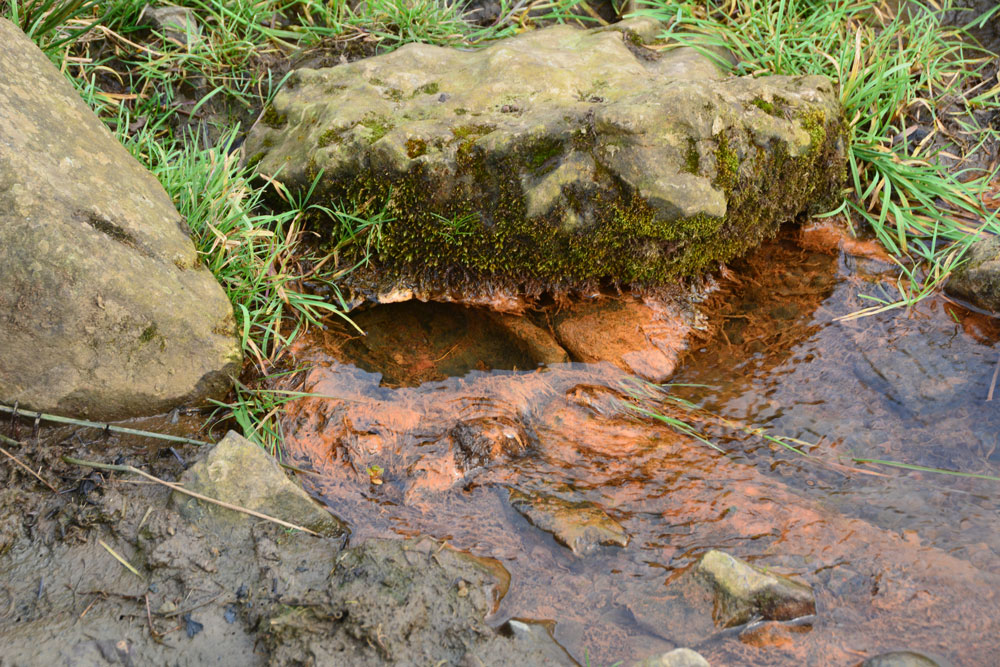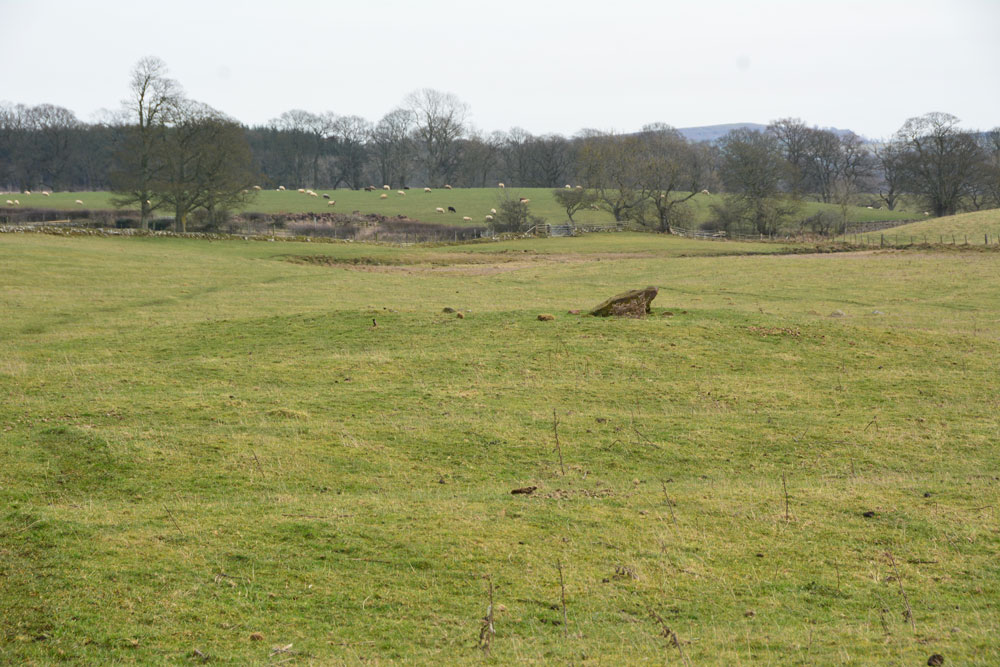Contributory members are able to log private notes and comments about each site
Sites Anne T has logged on trip number: 118 (View all trips)
View this log as a table or view the most recent logs from everyone
Fawns Moated Site
Trip No.118 Entry No.4 Date Added: 17th Feb 2019
Site Type: Misc. Earthwork
Country: England (Northumberland)
Visited: Yes on 14th Feb 2019. My rating: Condition 2 Ambience 4 Access 3

Fawns Moated Site submitted by Anne T on 17th Feb 2019. First view of the main part of this medieval moated site, with its lumps and bumps. Sadly on private land adjacent to the farm, and we could find no-one to ask permission to take a closer look. The footpath leading from the farmhouse, south east towards the cairn, gives good views back onto this site.
(View photo, vote or add a comment)
Log Text: Fawns Medieval Moated Site: "One of the few surviving examples in Northumberland and exceptionally well preserved" is how Historic England describe this site. As the third stop on our short circular walk to the east of Kirkwhelpington, this was a nice site to stop and look at. Easier to see the layout from the aerial photographs at home. Just a shame this site is on private land, as I'd have loved to have walked over the site to take a closer look.
There is much evidence of medieval field boundaries and rig and furrow ploughing all around here. The land looks rich and fertile, with magnificent sheep grazing in the fields.
Hallington Holy Well
Trip No.118 Entry No.1 Date Added: 15th Feb 2019
Site Type: Holy Well or Sacred Spring
Country: England (Northumberland)
Visited: Yes on 14th Feb 2019. My rating: Condition 3 Ambience 4 Access 4

Hallington Holy Well submitted by Anne T on 15th Feb 2019. Standing a little bit further down towards the field boundary, looking back at the small pool of water near where the spring emerges, and the much larger hollow of what we interpreted as the well pool (now dry). There is evidence of stones around the rim of the larger pool area, indicating there might have been a structure here at one time.
(View photo, vote or add a comment)
Log Text: Hallington Holy Well: We drove past this well, despite having the OS map with the location of the well marked. In the end we drove slowly back towards Hallington village, identifying the field because it is smaller than the others, with a fence line and line of trees that runs parallel to the road, about 100m away.
The gate into the field was open, but a large wooden shed indicates the field is usually used for horses. We walked south to the well pool, about 50m from the gate, coming across a large hollow with boulders/stones poking out of the bank; we interpreted this as having at one point having been a larger well pool.
The spring bubbles up from the western bank of the channel, just where the larger ‘pool’ narrows into the channel into which the water flows south to the field boundary. The water is clear and freely flowing. The collection of stones and wooden blocks leading across the mud indicated people still collect the water today, although I didn’t’ taste the waters.
This is a very lovely spot, and it was a great start of our afternoon out.
St George's Well (Kirkwhelpington)
Trip No.118 Entry No.3 Date Added: 15th Feb 2019
Site Type: Holy Well or Sacred Spring
Country: England (Northumberland)
Visited: Yes on 14th Feb 2019. My rating: Condition 3 Ambience 4 Access 4

St George's Well (Kirkwhelpington) submitted by Anne T on 15th Feb 2019. Standing just to the north and just upslope from the well, looking down across the pile of stones which protect the spring head, the small pool into which the water comes up into, and the channel down which the water runs to join a small stream running east-west along the bottom of the field.
(View photo, vote or add a comment)
Log Text: St George's Holy Well, Kirkwhelpington: The second stop of four on our short circular walk around Kirkwhelpington. This well is in a lovely location, very peaceful and quiet (once the farmer and his numerous dogs had driven off in his four-wheel drive buggy!). Two holy wells within a couple of hundred yards was a treat, although I'm interested in finding out how they became known as holy wells and what they cured.
The water emerges very peacefully up into a small pool at the base of the stones. By the time the water has gone a couple of metres further downslope, it is quite lively, creating ripples through the grass.
Boulders appear to mark the edge of the pool and water channel, although I couldn't see any signs of a permanent structure.
St Mary's Well (Kirkwhelpington)
Trip No.118 Entry No.2 Date Added: 15th Feb 2019
Site Type: Holy Well or Sacred Spring
Country: England (Northumberland)
Visited: Yes on 14th Feb 2019. My rating: Condition 2 Ambience 4 Access 4

St Mary's Well (Kirkwhelpington) submitted by Anne T on 15th Feb 2019. Whilst there is no sign of the well at the grid reference given, this spring bubbles up at the side of the small stream almost directly south. I wondered if the water from the well had been culverted down to here.
(View photo, vote or add a comment)
Log Text: St Mary's Well, Kirkwhelpington: We had previously stopped off at St Bartholomew's Church in the village, and photographed the sundial and some medieval grave slabs. Parking at the eastern end of the the village, almost opposite the entrance to Eastlands, we crossed the small bridge over the ford and headed up over the fields. Having passed the last houses to our left hand side, we let ourselves through the gate into the field and turned right (east). This was the start of a short circular walk which took in 2 holy wells, the ruins of a moated medieval manorial complex and a tumulus.
No signs of the well in the field, which should have been located about 50m due west of the only tall tree in this part of the field, but walking down by the small stream, I spotted a spring issuing out of the bank, with larger stones above it, and what appeared to be a small iron basin over which the water flowed. Has the water from the well been culverted down to here?
There was no end of rig and furrow around here. This land used to belong to Newminster Abbey, which used to own land up to the Scottish Borders. The ruins of the Abbey can be found in Morpeth town centre.
The Fawns (Kirkwhelpington)
Trip No.118 Entry No.5 Date Added: 17th Feb 2019
Site Type: Rock Art
Country: England (Northumberland)
Visited: Yes on 14th Feb 2019. My rating: Condition 2 Ambience 4 Access 3

The Fawns (Kirkwhelpington) submitted by Anne T on 17th Feb 2019. First view of the cairn as we made our way south east from the Fawns Moated Manorial Site up the hill. The cairn has been partly damaged by later ploughing, but the rig and furrow seem to respect the centre of the barrow. It is located at the foot of two hillocks which are prominent in the landscape. To the south, the gate out of this field crosses a small stream which needs to be stepped across.
(View photo, vote or add a comment)
Log Text: Cairn SE of The Fawns (220m west of Broom House farm): This cairn is easily visible from the top of the ridge, as we walked from the Fawns Farm/Moated Manorial Earthworks, along the footpath, then down hill. The brown blob of the rubbing post comes into sight first, then the circular mound of the cairn comes into view as you get nearer.
A lovely spot to be buried in - very peaceful and quiet, at the bottom of two hillocks, with a small stream (now) running to the south. The gate from this field onto the footpath back to the village crosses this stream, which needs a long stride to get over it, but it's not very deep.
Wish I'd been able to see the rock art panel and the urns, but a trip to London would be necessary (if the British Museum can find these!).
It is a gentle walk down to the river valley below from here, following ancient dry stone walls now white with lichen. We drove to Kirkharle for a cup of tea and some soup, then visited St Wilfred's Church just along the road, which is where Capability Brown was baptised (he was born in Kirkharle). We stopped to see a very strange monument dedicated to "A Most Unfortunate Man" at the side of the road between the church and Kirkharle Courtyard.
